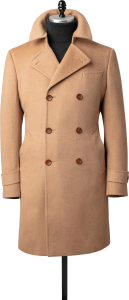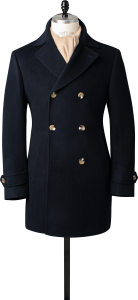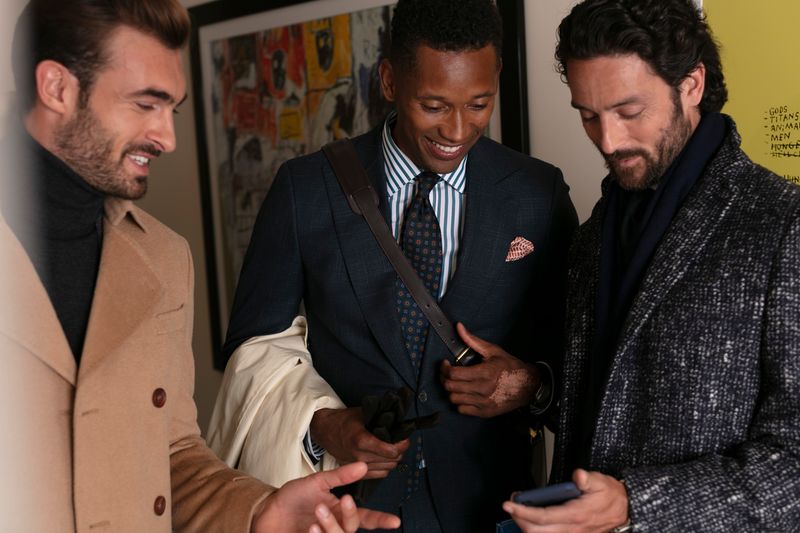Whether you’re dressing for a particularly snowy day or an unexpected springtime cold snap, an overcoat is the perfect article of clothing to keep you warm while still looking bold.
That’s why we think it’s good to know how to wear an overcoat.
The History of the Overcoat
A good overcoat typically comes in wool, or wool blended with another high-quality fiber, such as cashmere or camel hair. An overcoat should have some weight to it; your coat shouldn’t drag you down, but it needs to be heavy enough to protect you from harsh winds and thick enough to keep you dry when the world is rainy, snowy, or slushy.
The sleeves of your overcoat should be long enough to cover your jacket sleeves and shirt cuffs; the length of the hem is a matter of personal preference, though longer coats offer more protection. A hem that falls somewhere between the knees and calves is typical.
When you buy a custom overcoat, it’s best to get fitted while wearing the layers you expect to wear with the coat. If you plan on regularly wearing suits underneath it, have your measurements taken in your suit jacket. This helps make sure you’re getting the perfect fit.
If you’re on the short side, overcoats that stop at your shin or ankle may shorten your silhouette, while a coat cut just a few notches either below or above the knee will have a lengthening effect.
The overcoat can be styled up or down: Wear it over your suit and tie for professional occasions, or with fitted chinos and your favorite dress-casual footwear for less formal outings. If your coat includes a long belt, you may either buckle it or simply tie it in front the same way you’d fasten a bathrobe. You could also buckle the belt behind your coat to keep it out of your way and make it easier to take your coat on and off.

How to Wear an Overcoat: Modernizing a Classic
Overcoats come in dozens of styles, each featuring subtle variations on lapels, belt, buttons, length, and cut. The following popular outerwear picks are designed to keep you warm while looking your well-dressed best.
The Camel Hair Coat
Lightweight yet durable cloth woven from hair is a classic. It’s chosen for its combination of warmth and softness. Coats made from camel hair first rose to prominence in the wake of the Second World War when fabrics like silk and wool weren’t in supply. Camel hair cloth, while relatively unknown at that time, was easier to obtain, yet conveyed a similar sense of luxury.
While camel hair may be dyed any color, it’s most commonly left undyed; the natural color, a shade of pale yellowish caramel, is a hallmark of the coat. The natural tan color pairs especially well with other neutrals though a heather grey really stands out.
The Raincoat
A raincoat is a strong option during the fall and spring months when the weather is cool and unpredictable. Raincoats exist along a wide spectrum of quality and stylishness; if one is too large, fits poorly, or is made from cheap material, it’ll make you look—and feel—like you’re wearing a garbage bag.
This is a shame because a well-made raincoat can still be a stylish piece. Skip anything rubbery or too synthetic as it adds bulk and looks less slimming. Instead, go for water-resistant cotton that will be more versatile in your wardrobe.
Raincoats come in a wide range of colors, with earth tones and neutrals being perhaps the most common; they look especially fresh and modern in shades of olive, tan, and brown. Apart from fulfilling a very specific and useful function—keeping you dry in the rain—the right raincoat looks equally stylish for both formal and casual occasions.
The Trench Coat
The trench coat is a classic menswear item that has endured for more than a century. British Army officers first popularized trench coats during the First World War. They wore them in trenches on the battlefield, hence the name, then brought the style back home with them, where it quickly caught on with civilians.
Historically, trench coats were cut with ample room; after all, a military uniform had to fit underneath one. Today’s trenches toe the line between the original, roomier fit and sleeker, slimmer coats that have been updated for the modern man.
Trench coats are customarily double-breasted and belted and they often feature wide lapels, which are perfect for revealing a glimpse of a suit and tie beneath. For additional protection from cold weather, look for one with an insulated lining.
We recommend choosing a trench in a bold charcoal hue to pair with almost any color in your closet. Worn on top of a suit, a trench oozes class and sophistication and is sure to turn heads when you’re out and about.

The Pea Coat
By some definitions, a pea coat isn’t an overcoat at all; overcoats traditionally fall at least to the knee, while the hem of a pea coat generally lands somewhere mid-thigh. Pea coats take their name from the Dutch word pije, which refers to a coat made of heavy, rough wool.
First worn in the nineteenth century by officers and enlisted men in the British Navy, pea coats are traditionally double-breasted and cut short and roomy. Navy is the most popular color, though black, charcoal, and olive are also common.
The shorter length means pea coats tend to be less formal outwear options and they tend to pair more naturally with chinos and jeans than with suits. If you do wear a pea coat over a suit, make sure it’s long enough to completely cover the hem of your suit jacket.

For the Perfect Overcoat, Turn to Custom Menswear
Cold weather presents a challenge for men looking to satisfy the need to stay warm without compromising their style. Custom menswear will give you unlimited options—and it’s also the best way to ensure the perfect fit.
A sophisticated and stylish overcoat created to perfectly fit your body will keep you looking sharp while protecting you from the elements. Visit a Knot Standard showroom to meet with a personal stylist, who can take you through all your options in terms of fabrics, colors, patterns, and styles.
With a custom-crafted overcoat, you’ll fend off the weather without dampening your sense of style.
